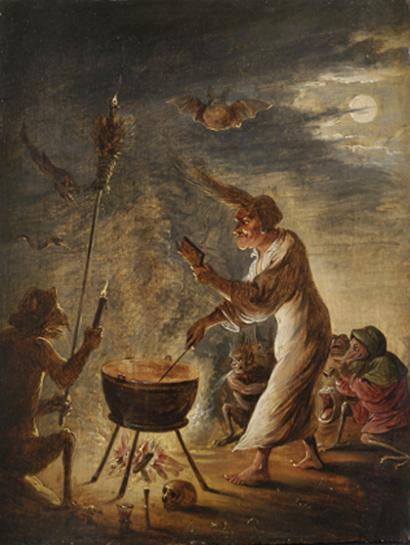- Bookmark / Share


- Delicious

- Scoopeo


- Technorati

- Digg

- Version française

BRUEGEL’S WITCHES
TILL 26 JUNE 2016
The iconic image of a witch was invented 450 years ago by Pieter Bruegel the Elder.
David Teniers II (circle of), Witches' scene, c. 1635
|
SINT-JANSHOSPITAALMariastraat 38, 8000 Bruges, Belgium INFORMATION:• Phone: +3250448743 OPENING TIMES:• Tue-Sun 09:30 - 17:00
ADMISSION PRICE:• €8: individuals (permanent collection included)
CONTACTS:• guided visits Phone: +3250444646
|
|
|
The iconic image of a witch Everyone knows what a witch looks like: an ugly old woman who flies up a chimney on a broomstick and then disappears into the night. In her hearth stands a huge cauldron, full of bubbling potions, while her evil black cat warms itself next to the crackling fire. It is less well known that this characteristic image of witchery was first invented and developed by artists working in Flanders and the Netherlands, with Pieter Bruegel the Elder leading the way. Two remarkable engravings Until the 16th century, there was no such thing as a stereotypical image of a witch. Two engravings by Pieter Bruegel changed that almost overnight. It was Bruegel who gave the witch her broomstick and cauldron. Such was his reputation and such was the quality of his engravings that artists throughout Flanders and the Netherlands were inspired to imitate his work. This led to the creation of an iconic image of witches that is still with us today. Important imitators More than 150 images of witches made by artists from the Low Countries have survived to the present day. This represents an output unequalled anywhere else in the world. For this exhibition, a fine selection of often fragile paintings, manuscripts, engravings and drawings have been gathered together in Bruges to tell the story of ‘Bruegel’s witches’. From rare archive pieces and manuscripts to the detailed depiction of sabbath scenes by Frans Francken and David Teniers the Younger. The absolute highlights are the prints by Pieter Bruegel: ‘St. James visiting the magician Hermogenes’ and ‘The fall of the magician Hermogenes’. In search of a scapegoat ‘Bruegel’s witches’ also gives an insight into the era in which this popular image of the witch was created. This is inextricably linked to the persecution of these wretched women, with the first public trials for witchcraft taking place around 1430. The exhibition highlights the consequences that can arise from a desire to exclude certain people from society, simply because they think and behave differently. In medieval times, the witch became a collective scapegoat for everything that was wrong in the world. Collaboration For this project, Musea Brugge has worked closely with the Museum of St. Catherine’s Convent in Utrecht, taking as a starting point the academic findings detailed in the thesis ‘Women on broomsticks and other such sorcery. Pieter Bruegel and the tradition of depicting witchcraft in the Netherlands between 1450 and 1700’ by Dr. Renilde Vervoort. In her doctoral dissertation at the Radboud University of Nijmegen in 2011, she demonstrated that the Dutch and Flemish Masters, and Pieter Bruegel in particular, had made a significant contribution to defining the way witches are still seen in society today. |
||

